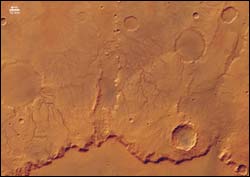Rim of Crater Huygens on Mars

Colour view of Huygens crater rim
These images, taken by the High Resolution Stereo Camera (HRSC) on board ESA’s Mars Express spacecraft, show the eastern rim of the Martian impact crater Huygens.
The images were taken during orbit 532 in June 2004 with a ground resolution of approximately 70 metres per pixel. The displayed region is centred around longitude 61° East and latitude 14° South.
Huygens is an impact structure, about 450 kilometres wide, located in the heavily cratered southern highlands of Mars. Crater counts of the rim unit of the impact basin indicate that it is almost 4000 million years old.
This implies that this basin was formed in the early history of the planet and indicates a period of heavy bombardment in roughly the first 500 million years of the planet’s lifetime.
The basin shows an inner ring that has been subsequently filled by sediments transported into the crater. These images show part of the eastern rim of the crater. The rim is heavily eroded and shows a ‘dendritic’ pattern. This observation suggests surface water run-off.
Dendritic systems are the most common form of drainage system found on Earth. They consist of a main ‘river’ valley with tributaries with their own tributaries. From above, they look like a tree or a river delta in reverse.
The valley system is blanketed by dark material, which was either transported by a fluid running through the channels or by wind-driven (‘aeolian’) processes. Part of the area has been covered by slightly redder material, which implies a different chemical composition.
Image resolution has been decreased for use on the internet. The colour images were processed using the nadir (vertical view) and colour channels.
The perspective views were calculated from the digital terrain model derived from the stereo channels.
The 3D anaglyph image was created from the nadir channel and one of the stereo channels. Stereoscopic glasses are needed to view the 3D image.
Media Contact
All latest news from the category: Physics and Astronomy
This area deals with the fundamental laws and building blocks of nature and how they interact, the properties and the behavior of matter, and research into space and time and their structures.
innovations-report provides in-depth reports and articles on subjects such as astrophysics, laser technologies, nuclear, quantum, particle and solid-state physics, nanotechnologies, planetary research and findings (Mars, Venus) and developments related to the Hubble Telescope.
Newest articles

Pinpointing hydrogen isotopes in titanium hydride nanofilms
Although it is the smallest and lightest atom, hydrogen can have a big impact by infiltrating other materials and affecting their properties, such as superconductivity and metal-insulator-transitions. Now, researchers from…

A new way of entangling light and sound
For a wide variety of emerging quantum technologies, such as secure quantum communications and quantum computing, quantum entanglement is a prerequisite. Scientists at the Max-Planck-Institute for the Science of Light…

Telescope for NASA’s Roman Mission complete, delivered to Goddard
NASA’s Nancy Grace Roman Space Telescope is one giant step closer to unlocking the mysteries of the universe. The mission has now received its final major delivery: the Optical Telescope…



